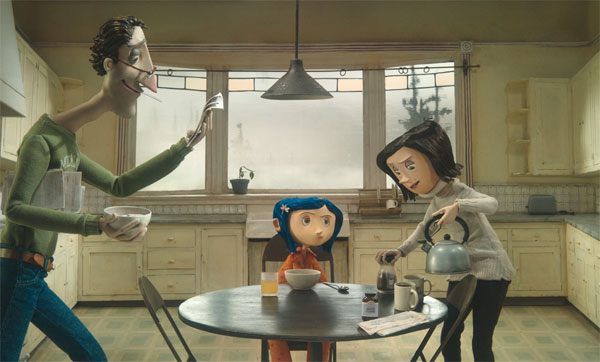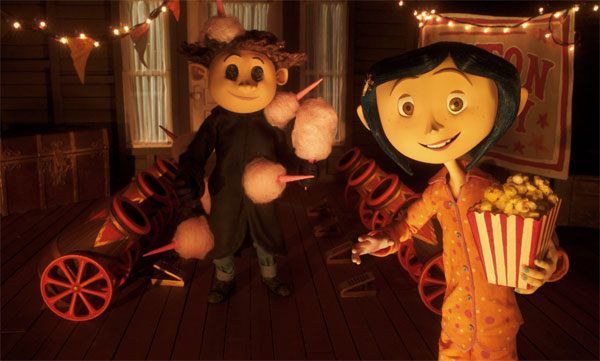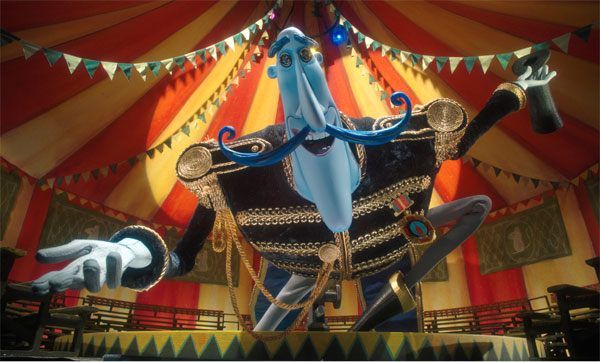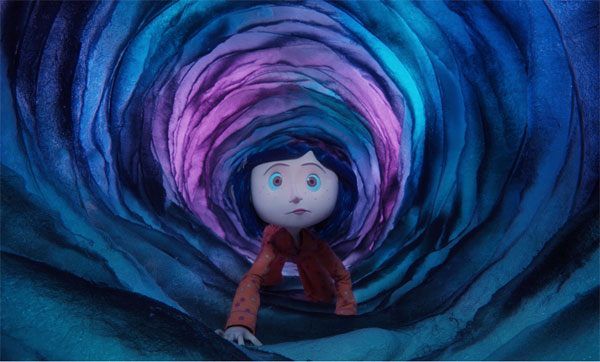
Most people seem to forget that The Nightmare Before Christmas was not actually directed by Tim Burton. Unfortunately Henry Selick rarely gets the credit owed to him as a great artist due to the overshadowing of Tim Burton on his career. I know people who even believe Selick’s stop-motion adaptation of James and the Giant Peach was directed by Burton. Hopefully Selick’s new film, Coraline, will change that and finally make clear the creative and artistic force he represents in the industry. That’s because Coraline, which was years in the making, stands out as Selick’s masterpiece and a beautiful entry into the world of modern animation.
The film is based Neil Gaiman’s acclaimed novel and the influence of his unique brand of fantasy storytelling is felt very strongly in the film. I haven’t read the book, so I cannot say how faithful the film is to its source, but I can’t imagine Gaiman would be anything but ecstatic with the final product.
Coraline is about a young girl, named Coraline (which nearly every character mistakes for Caroline,) who, with her mother and father, moves into a new apartment in a big old house. In one room Coraline discovers a locked door sealed behind a layer of wallpaper. At night the door magically opens and she goes through it only to be transported into a world almost exactly like her own, but everything is exactly how she would want it. Her “other” mother and father are more caring and pay more attention to her while her new friend, Wybie, has his mouth sewn shut so he can’t speak incessantly. She soon discovers that this other world may be hiding a darkly insidious force that must be stopped.

The film begins with Coraline’s arrival in the new apartment and sets up in very calm fashion the simple, boring, but slightly oddball world in which she lives. Her parents are writers for a horticultural magazine and as spend far too much time focused on their work with little time to spare for their daughter. What struck me immediately in these opening scenes was the quiet nature of the film. Most children’s films like to start off loud to capture the attention of the audience, but Coraline seemingly needs no such artificiality. Instead, the film relies more heavily on visual tone. Coraline’s world is dark and dreary, but it is slightly askew, making it less boring and more uncomfortable. It may be a simple and uninteresting place, but it is open to the unique potential of a child’s imagination.
The characters living in the other apartments are kooky and weird, and just like the apartment complex itself these people are not the types that a child would take interest in, but whose personalities and looks would make for wonderful dreams and playful stories. And this is exactly what we get in the “Other” world. The world just beyond the small door in the wall is magical and new. It is a place where everything is fascinating and fun and nothing is quite as it seems on the surface.
It is the perfect world for our young hero to carry on her adventures. In many ways the film is very similar to Guillermo del Toro’s Pan’s Labyrinth, and Coraline in particular is very reminiscent of that film’s leading protagonist, Ofelia. Both are creative young girls who are alienated from their respective worlds and find solace in a magical place that is hard to differentiate from a beautiful, or often nightmarish, dream. Both characters are also tenacious and incredibly brave. Coraline is especially fed up with her parents and the magical realm reflects her concerns realistically and poignantly.

The film also recalled Pan’s Labyrinth in its simply constructed but thematically dense and captivating fairy tale story. There is often little rhyme or reason to what happens except that it is by magic and magical convention, and this works brilliantly to underscore the childlike nature of the fairy tale being told. When Coraline has to find three magical eyes that look nothing like eyes in order to save the souls of three young children in order to go about saving her parents it all feels very arbitrary, but such is the nature of fairy tales, and in many ways is also the nature of a child’s existence. The ends are clear, but the means to those ends often feel illogical and created only to be an obstacle. The means still need to be accomplished though, and Coraline excels at playing out the adventures they create.
Her parents are not bad people, but as is the case in many modern families, work often takes priority over children, and the film captures this sad reality starkly. Coraline never attacks the parent characters. As an audience we don’t hate them. We are simply irked by the reality portrayed in them and wish they would acknowledge the bright young girl they have raised.
All these thematic elements are infinitely enhanced by the beautiful stop-motion animation on display. The movement of characters is very smooth, but not so smooth as to make them lifeless as though they had been poorly created by computer animation. The feeling is that the world we are viewing is tangibly real while also being detached from reality. This detachment serves to create a cold distancing effect in Coraline’s real world, while producing an animated warmth and vibrancy that allows the magical world to be emotionally inviting. It also helps that the animation is just so damn beautiful to watch. I would imagine that even if the story and character work weren’t so good I would still recommend the film for the visuals alone. Nearly every sequence in the film is utterly breathtaking.

Of course, the film is also in 3D, and this only adds to the beauty on hand. The third dimension is not used here as a gimmick, and it isn’t even used only for its simple effect of perceived added depth as seen in many new CG films. Selick instead uses the 3D effect to enhance the artistry of the visuals he has created. The sense is that the world we are witnessing truly exists right before our eyes. We are able to see the minute special details of the design work and the characters appear to truly bounce about in front of us as though the barrier of a screen is non-existent. The screen is not simply a window to the world of Coraline, but rather an opening through which the film’s elaborate sets and characters can almost be touched and felt. I have seen several films projected in 3D and none have used the technique so superbly and skillfully as in Coraline.
Dakota Fanning provides the voice of Coraline, and generally I can’t stand Fanning in movies, but here, using only her voice, she breathes life and confidence into her character. She sounds mature, but also young and vivacious. Teri Hatcher, of Desperate Housewives, delivers the other big speaking role, as Coraline’s mother, and she manages to be plain, sweet, caring and creepy, and often all at the same time. John Hodgman plays the father, and his voice is almost unrecognizable here because of the character’s quiet and monotone nature. The music in the film is generally understated, but what is there is both haunting and and mesmerizing. It helps with the film’s generally languid and dreamy pace, while also enhancing its eerie tone.

I’m not sure whether Coraline would actually be a frightening film for children, but for those old enough to sit through a moderately paced creepy dream-like film there are likely few better than this one. Selick brings to the medium a great maturity and uniquely imaginative styling that makes Coraline a perfect treat. It is a beautiful and dark story about childhood and it is a fantastic experience in animation. It is particularly spectacular in digital 3D, and I really can’t imagine watching it any other way. The film is so wonderful and the 3D effect is so good that I really do wish to see it again before it comes out on home video, limited only to its 2D presentation. There are a number of unique family films in the works for this year – including among them Spike Jonze’s Where the Wild Things Are and Wes Anderson’s own stop-motion adaptation of Fantastic Mr. Fox - and Henry Selick’s Coraline has truly set the bar high, and in the most magnificent fashion.


No comments:
Post a Comment